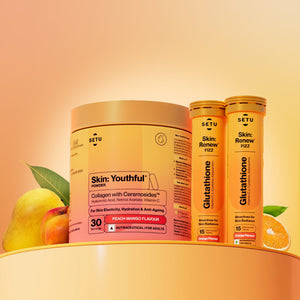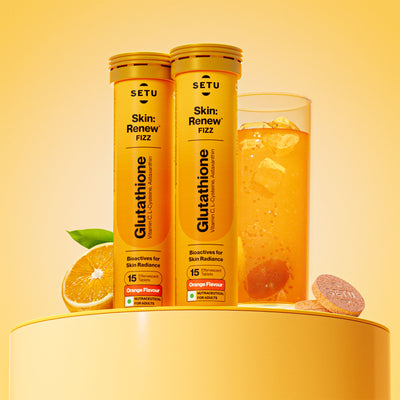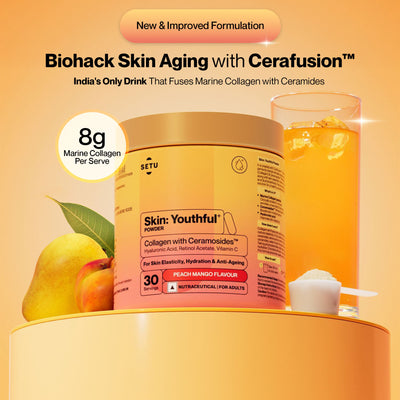Digest This! Volume 5: Sunscreen Science & UV Protection
21 May 2024
Shielding Your Skin From Harmful Rays
The sun, a symbol of vitality and energy, harbors a dual nature—its radiance sustains life, yet its ultraviolet (UV) rays can wreak havoc on your skin’s health. UV radiation, a component of sunlight, penetrates the Earth's atmosphere and reaches our skin's surface, where it can impact our skin's health. This paradoxical nature of the sun's influence underscores the importance of understanding and mitigating the risks associated with UV exposure.
Exposure to UV radiation poses a myriad of risks to our skin, ranging from cosmetic concerns like premature aging to more severe issues such as skin cancer. UV rays can penetrate the skin's layers, causing DNA damage and triggering cellular mutations that manifest as visible signs of aging, including wrinkles, fine lines, and age spots. Moreover, prolonged or intense UV exposure increases the risk of developing skin cancer, including melanoma, squamous cell carcinoma, and basal cell carcinoma, making it a significant public health concern worldwide.
In this article, we embark on a journey into the realm of photoprotection science—an interdisciplinary field dedicated to understanding how to shield our skin from the damaging effects of UV radiation. Through a combination of scientific research, skincare innovations, and proactive measures, we strive to create effective strategies that ensure your skin remains healthy, resilient, and shielded from the harmful effects of UV rays.
The Science
Delving into photoprotection science entails a deep dive into the intricate interactions between UV radiation and the skin, as well as the underlying mechanisms that drive UV-induced damage. UV radiation, emitted by the sun, consists of two primary types: Ultraviolet A (UVA) and Ultraviolet B (UVB). These rays differ in their penetration depth and the specific effects they exert on the skin.
- UVA Rays:
These possess the ability to penetrate deeply into the skin's layers, reaching the underlying dermis. This penetration depth makes them particularly insidious as they can induce damage to structures such as collagen and elastin fibers, which are crucial for skin elasticity and resilience. Consequently, UVA radiation is predominantly associated with photoaging, the process by which prolonged sun exposure accelerates skin aging, leading to the development of wrinkles, fine lines, and loss of firmness.
- UVB Rays:
These primarily affect the skin's outermost layer, the epidermis. These rays are responsible for causing sunburn, the visible manifestation of acute UV-induced skin damage. UVB radiation penetrates superficially, triggering inflammatory responses within the skin, resulting in erythema (redness), pain, and peeling. While UVB rays are primarily linked to short-term effects like sunburn, repeated exposure can contribute to long-term damage, including the development of skin cancer.
The cumulative effects of UVA and UVB radiation significantly contribute to skin damage and various dermatological conditions. Unprotected exposure to these rays initiates a cascade of cellular events within the skin, ultimately leading to DNA damage.
How Do UV Rays Impact Your Skin?
UV-induced mutations in skin cells can have diverse and often detrimental manifestations, ranging from immediate effects like sunburn to more long-term consequences such as an increased risk of skin cancer. Understanding these manifestations is crucial for appreciating the gravity of UV exposure and implementing effective UV protection and photoprotection measures.
- Sunburn
Sunburn, perhaps the most immediate and visible consequence of excessive UV exposure, results from the body's inflammatory response to UVB radiation. When UVB rays penetrate the skin, they cause damage to the DNA within skin cells, triggering the release of inflammatory mediators. This inflammatory response manifests as redness, pain, swelling, and in severe cases, blistering of the affected skin areas.
- Premature Aging
Prolonged UV exposure accelerates the aging process of the skin, a phenomenon known as photoaging. Exposure to UV radiation, particularly UVA rays, penetrates deep into the skin and damages collagen and elastin fibers, which are essential for maintaining skin firmness and elasticity. As a result, prolonged UV exposure leads to the development of premature aging signs such as wrinkles, fine lines, sagging skin, and a loss of overall skin tone and texture.
- UV Spots and Damage
Exposure to UV radiation can cause the formation of pigmented lesions and uneven skin tone, commonly referred to as UV spots or sunspots. These spots result from the overproduction of melanin—the pigment responsible for skin color—as a defense mechanism against UV damage. Additionally, UV exposure can exacerbate existing skin conditions such as melasma, hyperpigmentation, and post-inflammatory hyperpigmentation, leading to further skin discoloration and unevenness.
- Age Spots
Age spots, also known as liver spots or solar lentigines, are another common consequence of UV exposure. These flat, brown patches typically develop on sun-exposed areas of the skin, such as the face, hands, arms, and shoulders, and are more prevalent in older individuals. Age spots result from the cumulative effects of UV radiation, which trigger the overproduction and uneven distribution of melanin in the skin.
- Risk of Skin Cancer
Perhaps the most concerning consequence of UV-induced mutations is the increased risk of developing skin cancer. UV radiation damages the DNA within skin cells, leading to genetic mutations that can disrupt normal cellular function and promote uncontrolled cell growth—a hallmark of cancer. Prolonged or intense UV exposure significantly elevates the risk of developing various types of skin cancer, including basal cell carcinoma, squamous cell carcinoma, and the deadliest form, melanoma.
In summary, UV-induced mutations in skin cells can result in a spectrum of adverse effects, ranging from cosmetic concerns like sunburn and premature aging to more serious health risks such as skin cancer. UV protection through diligent sun protection practices and regular skincare is essential for maintaining skin health and reducing the risk of UV-induced damage.
Key Interventions
Alarmingly, research suggests that a substantial portion of skin aging—approximately 80%—can be attributed to sun exposure! Turns out, sun protection is more vital than we think.
This shows us the critical importance of implementing effective photoprotection strategies to mitigate the adverse effects of exposure to UV radiation. Through proactive UV protection and photoprotection, we can minimize the risk of sun-induced skin damage and preserve the health, youthfulness, and vitality of our skin for years to come.
From sunscreen formulations that act as a barrier against UV rays to antioxidant-rich skincare products that neutralize free radicals and promote skin repair, the quest for effective photoprotection encompasses a diverse array of approaches. By exploring these strategies and their scientific foundations, we empower ourselves to make informed decisions about sun protection and skincare, ultimately promoting the long-term health and vitality of our skin.
- Don’t skip the sunscreen
Sun protection is super important for your skincare routine! Sunscreen emerges as a frontline defense against UV radiation. Formulated with active ingredients such as zinc oxide and titanium dioxide, sunscreen acts as a physical barrier, absorbing, reflecting, or scattering harmful UV rays. Broad-spectrum sunscreens offer comprehensive UV protection – against both UVA and UVB rays – mitigating the risk of skin damage and aging. Scientific evidence corroborates the efficacy of sunscreen in delaying skin aging and reducing the incidence of skin cancer, underscoring its indispensable role in daily skincare routines.
- Include collagen in your routine
UV radiation impairs collagen, the structural protein crucial for skin elasticity. Incorporating collagen and collagen-boosting ingredients into skincare regimens can mitigate the adverse effects of UV damage, promoting skin firmness, hydration, and resilience. Essential co-factors such as vitamin C, hyaluronic acid, and zinc synergize with collagen, stimulating collagen synthesis and facilitating skin repair processes. Choose a collagen powder that contains Type 1 and 3 collagen, along with skin-boosting ingredients like hyaluronic acid or zinc. You can find that in Setu’s Skin: Youthful - Marine Collagen powder, which also contains vitamin C and biotin, along with all these other powerful ingredients! By bolstering collagen levels, you can counteract the deleterious effects of exposure to UV radiation, preserving skin youthfulness and vitality.
- Opt for advanced photoprotection
Integrating potent antioxidants like glutathione into skincare routines enhances photoprotection efficacy. Glutathione acts as a formidable shield against UV-induced oxidative stress, inflammation, and free radical damage, mitigating the severity of sunburns, UV damage, and pigmentation. It offers sun protection from within. Complementary antioxidants such as vitamin C, E, and niacinamide augment glutathione’s photoprotective properties, fortifying the skin’s resilience against environmental stressors and promoting long-term skin health. Make sure you consume a safe, optimum dose of 500mg of Glutathione, and if your supplement contains added vitamin c, that’s even better. Vitamin C enhances the benefits of glutathione, and together, they work wonders for skin health. That’s why Setu’s Skin: Renew - Glutathione contains both these miracle ingredients!
Clinical Studies Supporting Efficacy
Numerous clinical studies validate the efficacy of photoprotection strategies and collagen-boosting interventions in safeguarding skin health. These studies elucidate the mechanisms underlying the protective effects of sunscreen, collagen supplementation, and antioxidant-rich formulations against UV-induced damage, underscoring their pivotal role in mitigating the adverse effects of sun exposure. By leveraging scientific insights and evidence-based interventions, you can proactively embrace sun protection and combat UV radiation, ensuring its longevity, radiance, and vitality.
See More Studies →
Conclusion
In concluding our exploration of exposure to UV radiation and its impact on skin health, it becomes evident that the relationship between the two is multifaceted and consequential. The intricate interplay between UV rays and the skin underscores the paramount importance of implementing robust photoprotection strategies.
UV-induced mutations in skin cells can exert profound and far-reaching effects, extending beyond mere cosmetic concerns to encompass significant health risks. By prioritizing sun protection measures, such as wearing broad-spectrum sunscreen, seeking shade, and wearing protective clothing, individuals can mitigate the damaging effects of UV radiation and preserve the health, youthfulness, and vitality of their skin.
Moreover, adopting a comprehensive skincare regimen that incorporates collagen-boosting ingredients, antioxidants, and other skin-nourishing compounds can further fortify the skin's natural defenses against UV-induced damage. By embracing these proactive photoprotection strategies and promoting sun-safe behaviors, we not only protect our skin from harm in the present but also lay the foundation for long-term skin health and resilience.
A win-win for radiant, sunkissed skin!
Radiant Skin Combo: Glutathione & Marine Collagen
- ₹2,139
- ₹2,139
-
₹3,500 - ( 38% OFF)
Categories
- Choosing a selection results in a full page refresh.
- Press the space key then arrow keys to make a selection.
this is the sidecart















